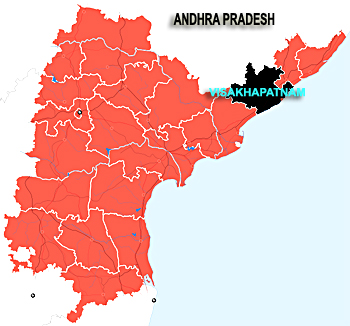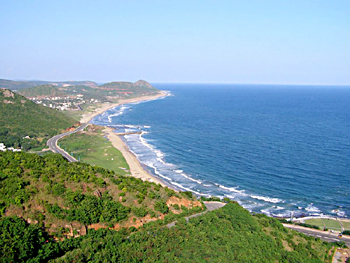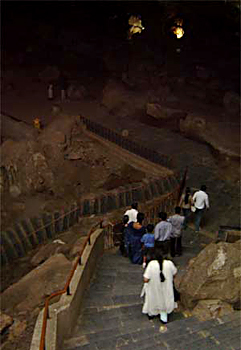 Visakhapatnam district is located towards north-eastern coastal Andhra Pradesh. It is also known by the name of Visakha Zila. The administrative headquarter of the district is Visakhapatnam. Presently the district is one of the busiest commercial and industrial regions of the country.
Visakhapatnam district is located towards north-eastern coastal Andhra Pradesh. It is also known by the name of Visakha Zila. The administrative headquarter of the district is Visakhapatnam. Presently the district is one of the busiest commercial and industrial regions of the country.
History of Visakhapatnam District
According to the sayings of Hindu mythology, Visakhapatnam was named after the god of valour, Vaisakha. During 260 BC, Visakhapatnam had been a small fishing village and was part of the Kalinga under Ashoka. After the reign of Ashoka, the district had been ruled by several Andhra rulers, the Vengis, the Pallavas, the Cholas and the Gangas. Before the region was taken over by the British, it was under the domination of the Vijaynagar Empire.
Geography of Visakhapatnam District
The district lies between 17o - 15` and 18o -32` Northern latitude and 18o - 54` and 83o - 30` in Eastern longitude. The north of the district is partly bounded by Orissa and partly by the Vizianagaram District. East Godavari District borders Visakhapatnam towards the south. On the west it is bounded by Orissa and Bay of Bengal is towards the east of the district.
 The region can be divided into two major geographic divisions. They are the Agency Division and the Plains Division. The Agency Division is dotted by several peaks and plateaus whereas in the plains division the altitude of the region does not extend beyond 75 meters. The district experiences differing climate throughout the district. Near the costal areas the climate is moist and comfortable but in the interior region the climate is warm, whereas climate in the hilly areas are cool on account of the elevation.
The region can be divided into two major geographic divisions. They are the Agency Division and the Plains Division. The Agency Division is dotted by several peaks and plateaus whereas in the plains division the altitude of the region does not extend beyond 75 meters. The district experiences differing climate throughout the district. Near the costal areas the climate is moist and comfortable but in the interior region the climate is warm, whereas climate in the hilly areas are cool on account of the elevation.
The average rainfall of the region is 1202mm of which most of the rain is caused by the south-west monsoon.
Most of the areas in the region have red loamy soils which are characterized by poor texture and easy drainablity. Regarding flora and fauna of the region, it can be said that around one-third of the region is covered by moist and dry deciduous forests. Fauna of the region includes 13.43 lakh of livestock.
Demography of Visakhapatnam District
According to the census of 2001, the district has a population of 38.32 lakh and the density of population in the district is 343 persons per square kilometer. The density of the population is more in the plain divisions than in the Agency Division. The sex ratio of the region is 985 females per thousand males and most of the people in the Visakhapatnam district dwell in the villages. The literacy rate in the region is 52.25 percent of which more number of males are literate than the number of females.
Visakhapatnam district has a work force equal to 16.03 lakh as per the census of 2001.
 As far as education of the district is concerned it has a number of primary and secondary schools to which large number of students are enrolled. Besides the schools, there are also a number of professional colleges and general colleges which benefit huge number of students annually.
As far as education of the district is concerned it has a number of primary and secondary schools to which large number of students are enrolled. Besides the schools, there are also a number of professional colleges and general colleges which benefit huge number of students annually.
Economy of Visakhapatnam District
The principal occupation of the people of Visakhapatnam is agriculture; almost 70 percent of the households in the region are engaged in agriculture. Rice is the most common crop grown by the farmers of Visakhapatnam. The other cash crops which are grown in the region are sugarcane, groundnut, Chillies and sessamum.
The other allied economic activities of the region are animal husbandry and fishing.
Besides these economic activities in the recent past there has been a lot of industrial development in the region. Some of the major industries of the region are Hindustan Shipyard, Hindustan Petroleum Corporation, Visakhapatnam Steel Plant and a lot more.
Some of the agro based industries of the region are sugar factories, rice mills, jute mills etc. The recent economic development of the region has been aided by the well developed communication system of the district.
Tourism of Visakhapatnam District
The tourism industry in the district of Visakhapatnam district has flourished because the region has a combination of sprawling beaches as well as lush green mountains. Besides the lakes, cool beaches, caves and valleys there are many tourism spots in the district which represent the true heritage and culture of India. The Araku Valley in the district of Visakhapatnam is a must visit for all the tourists. The Kailasa Giri which has lush green meadows is a treat of the eyes for every onlooker. The Borra Caves is also an important tourist destination.
Some of famous beaches of the region are Ramakrishna Beach, Rishikonda Beach, Lawson`s Beach and many more are absolutly perfect destinations for rejuvenation of the soul. The Simhachalam Varaha Lakshminarasimha Temple, the Buddhist shrines, the Dutch Tombs, Visakhapatnam Fort are other places of interest in the district.
Tourism in the district of Visakhapatnam is all the more flourished because it is well connected by air with all the metro cities of the Indian subcontinent. Besides the air route, the region is also well connected by rail and road.



















